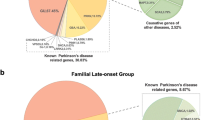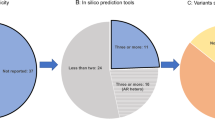Abstract
Recently, RAB39B mutations were reported to be a causative factor in patients with Parkinson’s disease (PD). To validate the role of RAB39B in familial PD, a total of 195 subjects consisting of 108 PD families with autosomal-dominant (AD) inheritance and 87 PD families with autosomal-recessive (AR) inheritance in the Chinese Han population from mainland China were included in this study. We did not identify any variants in the coding region or the exon-intron boundaries of the gene by Sanger sequencing method in the DNA samples of 180 patients (100 with AD and 80 with AR). Furthermore, we did not find any variants in the RAB39B gene when Whole-exome sequencing (WES) was applied to DNA samples from 15 patients (8 with AD and 7 with AR) for further genetic analysis. Additionally, when quantitative real-time PCR was used to exclude large rearrangement variants in these patients, we found no dosage mutations in RAB39B gene. Our results suggest that RAB39B mutation is very rare in familial PD and may not be a major cause of familial PD in the Chinese Han Population.
Similar content being viewed by others
Introduction
Parkinson’s disease (PD) is a common late onset neurodegenerative disorder, clinically characterized by a series of motor symptoms and non-motor symptoms. The classical motor symptoms such as bradykinesia, rigidity, rest tremor, and postural instability have been widely recognized as prominent components of PD1. PD is a complex disease with a combination of environmental exposures as well as the effect of multiple gene mutations. Previous studies reported that about 10% of the patients have a positive family history of PD and that a series of genes, such as SNCA, LRRK2, VPS35, Parkin, PINK1, and DJ-1, were associated with the disease2.
A recent publication by Wilson et al. reported that mutations of the RAB39B gene were responsible for the cause of X-linked intellectual disability and early-onset PD in two unrelated families that come from Australian and the USA (Wisconsin)3. Their study identified a ~45 kb deletion resulting in complete deletion of the RAB39B gene in family A. A missense mutation, c.503C > A(p.Thr168Lys) in the RAB39B gene, was found in family B, which had been described 30 years ago4. The Threonine residue was shown to be evolutionarily-conserved3. In another group, Mata et al. reported a missense mutation, c.574G > A (p.Gly192Arg), in a North American family of European origin; the affected family members were characterized with a classical PD phenotype. This mutation was predicted to be deleterious as defined by Combined Annotation Dependent Depletion (CADD)5. More recently, Lesage et al., reported a new truncating mutation (p.W186stop) in the RAB39B gene in a PD patient of French origin6. Previous studies have suggested that the RAB39B gene is causative of familial PD in different ethnic groups. To validate the role of the RAB39B gene in susceptibility to familial PD in the Chinese Han population, we conducted this study in 195 families consisting of PD patients with AD and AR inheritance, in whom the common causative genetic mutations, in genes such as SNCA, LRRK2, UCHL1, HtrA2, GIGYF2, EIGIF4, parkin, PINK1, DJ-1, ATP13A2, and PLA2G6, had previously been excluded7,8,9.
Methods
Patients
All the patients were treated in the Xiangya Hospital Neurology department from January 1995 to May 2015 throughout the study. Written informed consent was obtained from each subject. The work received approval from the institutional ethics committee of Xiangya hospital. We conducted this study in 108 AD inherited PD patients (mean age at onset, 47.82 ± 11.6 years, 57% males) and 87 AR inherited PD patients (mean age at onset, 49.19 ± 15.05 years, 55.7% males) from the Chinese Han population. Patients who had a positive family history of PD (2 or more patients in 1 family) were diagnosed by at least 2 professional neurologists according to the United Kingdom PD Brain Bank Criteria10.
Genetic analysis
Genomic DNA from patients was extracted from peripheral blood by using standard protocols8. Polymerase chain reaction (PCR) analysis of the RAB39B gene was carried out by using 2 pairs of primers. The 2 pairs of primers were designed to cover the whole coding region and exon-intron boundaries of the RAB39B gene (the details of primer sequences are listed in Table 1), and 180 probands were genotyped by Sanger sequencing. The analysis of an additional 15 individuals from unrelated families (8 with AD and 7 with AR inheritance) was performed using Whole-exome sequencing (Beijing Genomics institution, BGI, China). The mean of 90% of exome target region reads had coverage of, at least 30× for further genetic analysis. The SureSelect Human All ExonV5 Kit (Agilent,USA) was used for exome targeted regions capture. Subsequently, the captured regions were sequenced using Hiseq 2000 platform (Illumina, CA) and aligned to the reference human genome database hg19. Burrows-Wheeler Aligner (BWA), Picard tools and Genome Analysis ToolKit (GATK) tools were used for sequence data alignment, duplicate reads assess and variation detection, respectively11. Then, the detected variations were catalogued by Annovar, and common variations were filtered with dbSNP, 1000 Genomes Project and HapMap database (Minor Allele Frequency, MAF ≥ 1%), variants that didn’t present in these databases were considered novel12.
Furthermore, all patients were excluded with large and complex rearrangement mutations in RAB39B when analyzed by quantitative Real-Time PCR (qRT-PCR). Another 2 primer pairs were designed spanning the exon and intron of RAB39B, and GAPDH was selected as an internal control gene (the details of primer sequences are listed in Table 2). The concentrations of all DNA samples were diluted to be at 20–30 ng/ul, and the amplification efficiencies of the target gene and reference gene were approximately equal. qRT-PCR was performed on the Bio-Rad CFX96 in 96-well (Bio-Rad Laboratories, Lnc, United Kingdom) Multiplate® PCR PlatesTM. PCR reaction conditions were based on the standard procedures recommended by the manufacturer (Thermo Scientific, Maxima SYBR Green qPCR Master Mix (2X), #K0251). All samples and negative controls were amplified in triplicate and 2−△△CT method was used to analyze the relative changes in gene expression. All the methods were carried out in accordance with the approved guidelines8,13.
Results
We did not identify any variants in the RAB39B gene (including single nucleotide polymorphism, synonymous and intronic variants) among the 195 familial PD patients by Sanger sequencing. WES results also showed no variants in the whole RAB39B gene. Moreover, relative quantification by qRT-PCR showed that the relative copy number of RAB39B expression in our 195 PD individuals was between 0.8–1.2 in female PD patients and 0.45–0.6 in male PD patients, which meant that there were no dosage mutations (such as large and complex rearrangements mutations) in RAB39B gene among our familial PD patients.
Discussion
The RAB39B gene is located at chromosome Xq28 and encodes a member of the Rab family protein, which plays a role in vesicular trafficking of eukaryotic cells. Since it was first identified in 2002, previous studies have reported that the mutations of RAB39B can lead to many neurological disorders, such as X-linked mental retardation (XLMR), Charcot-Marie-Tooth disease (CMT), and Warburg Micro syndrome14,15. Recently, Wilson and colleagues reported a missense mutation c.503C > A (p.Thr168Lys) and a complete deletion of RAB39B which was associated with a complex disease including atypical PD symptoms and intellectual disability. In addition, another mutation including c.574G > A missense mutation and c.557G > A truncating mutation were reported in different ethnic PD patients, suggesting that RAB39B may be a causative factor in familial PD patients. In our former study, we didn’t find any association between RAB39B and early-onset PD in Chinese patients16. Therefore, this study was conducted to further validate the role of RAB39B in familial PD patients among Chinese Han population (patients in these two studies have no overlapping). However, we did not find any relationship between them. In summary, our study suggested that RAB39B mutation is rare in Chinese PD patients, both in sporadic early onset PD patients and familial PD patients.
Additional Information
How to cite this article: Kang, J.- et al. RAB39B gene mutations are not linked to familial Parkinson’s disease in China. Sci. Rep. 6, 34502; doi: 10.1038/srep34502 (2016).
References
Kalia, L. V. & Lang, A. E. Parkinson’s disease. Lancet. 386, 896–912 (2015).
Verstraeten, A., Theuns, J. & Van Broeckhoven, C. Progress in unraveling the genetic etiology of Parkinson disease in a genomic era. Trends Genet. 31, 140–149 (2015).
Wilson, G. R. et al. Mutations in RAB39B cause X-linked intellectual disability and early-onset Parkinson disease with alpha-synuclein pathology. Am. J. Hum. Genet. 95, 729–735 (2014).
Laxova, R. et al. An X-linked recessive basal ganglia disorder with mental retardation. Am. J. Med. Genet. 21, 681–689 (1985).
Mata, I. F. et al. The RAB39B p.G192R mutation causes X-linked dominant Parkinson’s disease. Mol. Neurodegener. 10, 50 (2015).
Lesage, S. et al. Loss-of-function mutations in RAB39B are associated with typical early-onset Parkinson disease. Neurol. Genet. 1, e9 (2015).
Li, K. et al. Analysis of EIF4G1 in ethnic Chinese. BMC. Neurol. 13, 38 (2013).
Shi, C. H. et al. PLA2G6 gene mutation in autosomal recessive early-onset parkinsonism in a Chinese cohort. Neurology 77, 75–81 (2011).
Guo, J. F. et al. Mutation analysis of Parkin, PINK1, DJ-1 and ATP13A2 genes in Chinese patients with autosomal recessive early-onset Parkinsonism. Mov. Disord. 23, 2074–2079 (2008).
Hughes, A. J. et al. Accuracy of clinical diagnosis of idiopathic Parkinson’s disease: a clinico-pathological study of 100 cases. J. Neurol. Neurosurg. Psychiatry. 55, 181–184 (1992).
Li, H. & Durbin, R. Fast and Accurate Short Read Alignment with Burrows-Wheeler Transform. Bioinformatics. 25, 1754–1760 (2009).
DePristo, M. A. et al. A Framework for Variation Discovery and Genotyping Using Next-Generation DNA Sequencing Data. Nat genet. 43, 491–498 (2011).
Livak, K. J. & Schmittgen, T. D. Analysis of relative gene expression data using real-time quantitative PCR and the 2(-Delta Delta C(T)) Method. Methods 25, 402–408 (2001).
Giannandrea, M. et al. Mutations in the small GTPase gene RAB39B are responsible for X-linked mental retardation associated with autism, epilepsy, and macrocephaly. Am. J. Hum. Genet. 86, 185–195 (2010).
Cheng, H. et al. Isolation and characterization of a human novel RAB (RAB39B) gene. Cytogenet. Genome. Res. 97, 72–75 (2002).
Liu, Z., et al. Mutations analysis of RAB39B gene in Chinese early-onset Parkinson’s disease. Parkinsonism Relat. Disord. 28, 157–8 (2016).
Acknowledgements
We would like to thank all individuals participating in the study. This work was supported by grants 81361120404, 81430023 and 81130021 from the National Natural Science Foundation of China (to Drs Bei-sha Tang), grant 81171198 from the National Natural Science Foundation of China (to Drs Xin-xiang Yan), grants 81371405, 81571248 from the National Natural Science Foundation of China (to Drs Ji-feng Guo), grant 2016CX025 from innovation-driven plan of Central South University (to Drs Ji-feng Guo).
Author information
Authors and Affiliations
Contributions
J.-f.K., B.-s.T. and J.-f.G. contributed to the conception and design of the study. Q.-y.S., Y.Y., K.L., Z.-h.L., Q.X. and X.-x.Y. conducted clinical assessments and sample collection. J.-f.K. Y.L., C.-m.W. and Z.-h.L. performed genetic analysis. J.-f.K. and J.-f.G. wrote the main manuscript and critically revising the article. J.-f.G. accepts full responsibility for the work and controlled the decision to publish. All authors have reviewed the final submitted manuscript.
Corresponding author
Ethics declarations
Competing interests
The authors declare no competing financial interests.
Rights and permissions
This work is licensed under a Creative Commons Attribution 4.0 International License. The images or other third party material in this article are included in the article’s Creative Commons license, unless indicated otherwise in the credit line; if the material is not included under the Creative Commons license, users will need to obtain permission from the license holder to reproduce the material. To view a copy of this license, visit http://creativecommons.org/licenses/by/4.0/
About this article
Cite this article
Kang, Jf., Luo, Y., Tang, Bs. et al. RAB39B gene mutations are not linked to familial Parkinson’s disease in China. Sci Rep 6, 34502 (2016). https://doi.org/10.1038/srep34502
Received:
Accepted:
Published:
DOI: https://doi.org/10.1038/srep34502
Comments
By submitting a comment you agree to abide by our Terms and Community Guidelines. If you find something abusive or that does not comply with our terms or guidelines please flag it as inappropriate.



